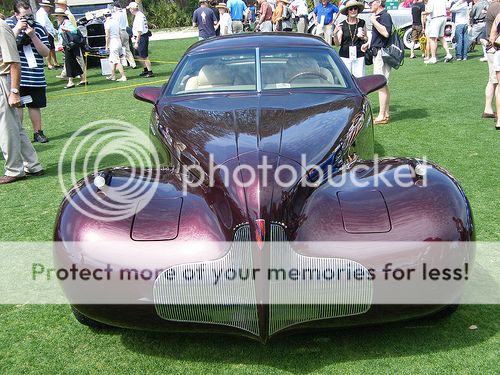 The Buick Blackhawk is not just any customized car – it’s designed to emphasize Buick’s heritage of distinctive design and outstanding power for the specialized audiences that attend custom/hot rod shows. "This is a very special show car," said Michael E. Doble, Buick’s special vehicles manager: "It has classic styling combined with contemporary proportions. If you’re talking about customized cars, the Blackhawk is the ultimate expression of Buick." Retractable convertible with styling from the ‘30s.
The Buick Blackhawk is not just any customized car – it’s designed to emphasize Buick’s heritage of distinctive design and outstanding power for the specialized audiences that attend custom/hot rod shows. "This is a very special show car," said Michael E. Doble, Buick’s special vehicles manager: "It has classic styling combined with contemporary proportions. If you’re talking about customized cars, the Blackhawk is the ultimate expression of Buick." Retractable convertible with styling from the ‘30s.The Blackhawk is basically a 2-plus-2 convertible with a retractable top, and a body that looks like it came out of the late 1930s or ‘40s – because it did. Its face is a classic 1939 Buick grille, which has a pattern of fine vertical bars, and its major sheet metal combines the sleek bodies of 1941 and 1948 Buick Roadmasters.
All of this except the grille has been modified, and the final appearance – featuring black cherry paint, doors without handles and hidden headlamps – is of a streamlined yet retro head-turner that looks like it was created specifically for the Woodward Dream Cruise.
In a sense it was. Doble has been in charge of creating Buick show and concept cars as well as some specialty production models for the last 15 years. Mostly, his Buick concepts have been built to headline major auto shows at Detroit, Los Angeles, Chicago and New York. But the Blackhawk was created to fill a different need – one he perceived when he attended custom and hot rod shows and caught the enthusiasm of their crowds.
"The folks who attend those shows are very excited and knowledgeable about cars," he said. "We felt we needed a custom Buick for that audience, but not a hot rod. Hot rods tend to have simple bodies, exposed engines, large rear wheels and lots of chrome. But when you build a custom, it’s like you’re redesigning a car.
"The Blackhawk is a highly altered car, picking up design cues from Buick’s heritage. It will be a great showpiece for a lot of events as we head toward Buick’s centennial in 2003."
To Buick General Manager Roger W. Adams, the Blackhawk creates "a very interesting statement for Buick to make as we approach our centennial. Buicks have always had a strong element of power and distinctive style – and this is a good time to remind folks of that."
He said Buick leaders have long promoted the marque’s upscale image and such key Buick attributes as comfort, convenience, safety and security. But in the last couple of years there has been new emphasis on more expressive Buicks.
One example is the 1999 concept Cielo, a " no-compromise" convertible with roof rails and retractable top. Another is the 2000 concept LaCrosse, described as a "drop-dead gorgeous" flagship sedan, which packages styling cues from Buick’s past (such as vertical-bar grille, portholes and side sculpture from the ‘50s) in a refreshing way. LaCrosse, incidentally, can also reveal a pickup-type rear cargo area on a single voice command. Still another example is Rendezvous, a production Buick SUV for the 2002 model year that Adams says is more versatile than any other vehicle in its class.
The Blackhawk, while not intended for major auto shows, adds to that new trend with a more aggressive take on styling heritage and power. And, Doble said, the Blackhawk is "no trailer queen." It’s meant to be driven, maybe even from custom show to custom show across the country.
Blackhawk power: 463-hp V-8; 0-60 in under 5 seconds. The Blackhawk’s performance goal is 0-60 miles per hour in under 5 seconds. Its powertrain is a 1970-vintage 455-cubic-inch Buick GS Stage III V-8 engine, heavily detailed and mated to the latest electronically controlled four-speed automatic transmission. The naturally aspirated, overhead valve, fuel-injected engine generates 463 horsepower at 4600 rpm and 510 lb-ft of torque at 4200 rpm.
While Doble had the idea of creating a great Buick custom car with heritage overtones, he did not create the Blackhawk. He took his ideas to five companies and they came back with a number of creative concepts, all of which were well received by Doble. Finally he chose one of four concepts submitted by Steven D. Pasteiner, a former Buick designer who owns a design and prototype company, Advanced Automobile Technologies, in Rochester Hills, Mich.
Pasteiner had done major design work on a number of Buick concepts over the years – such as Questor, Sceptre, Park Avenue Essence, Signia and XP2000, all well-known names to students of industry dream cars. He had also designed such production Buicks as GS models of the late 1960s and Regals from the 1970s until he left General Motors Design to create his own company in 1989.

















No comments:
Post a Comment